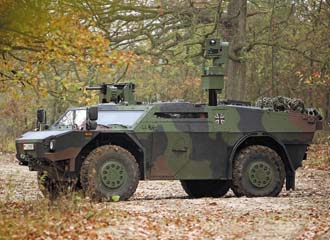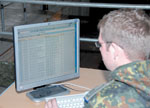German Division Deploying to Afghanistan With Commercial Software for Logistics Support
 |
The German armored reconnaissance vehicle Fennek will be one of the first armed forces vehicles to be fully supplied by the Systems Applications and Products in Data Processing (SAP) for Defense Forces and Public Security (SASPF) after deployment to Afghanistan. |
Automated logistics software based on commercial standards will make its combat debut next year when
Systems Applications and Products in Data Processing software, commonly known as SAP, is generally used in the business world for financial accounting, controlling, product planning, materiel management and sales and distribution. Under the multibillion dollar HERKULES contract, the German Federal Defense Force, the Bundeswehr, is undergoing a massive overhaul of its business processes using the modified application SAP for Defense Forces and Public Security, or SASPF. The SASPF offers a wide range of automated functions, including logistical management, materiel management and maintenance, decentralized procurement and usage control processes.
The 1st Armored Division will deploy to
“The major advantage of the integrated SASPF system is the high degree of transparency. The SASPF covers the complete supply chain. You can optimize your logistics to the needs of your troops and to the costs to increase efficiency,” says Bernd Zimmermann, the staff officer for rollout management within the Bundeswehr’s Information Technology Office.
For example, when a vehicle breaks down in a country of deployment, the home base supply section will be informed automatically about what spares are needed. At the same time, the operations headquarters is informed about how many vehicles are actually operationally ready. In such a case, the SASPF is expected to save work and money in terms of inventory costs.
The SASPF became fully operational with the 1st Armored Division in 2009 after extensive testing, and reached a fully operational capability with the 13th Mechanized Infantry in June. The SASPF implementation marks the first time the Bundeswehr has tried to apply commercial standard software to its business processes. The software replaces numerous information technology systems, including systems for materiel management. It replaced five different systems for the 1st Armored Division alone. The systems being replaced are not interoperable, or do not share data with one another, so the SASPF vastly streamlines the German armed forces information technology infrastructure and processes. The software brings transparency in logistics data and consistency in master data and documents, so information will be readily available to users online.
Automated logistics processes make a world of difference on the battlefield, according to Col. Merle Russ,
Maintaining iron mountains of supplies is expensive and places heavy demands on scarce Army resources, including personnel, available space on transporters and storage space. Furthermore, the information technology systems used at the time were incompatible with one another, often were unreliable and offered dissimilar information. As a result of the poorly flowing information, the networks were overloaded with status update requests from the field.
“Logistics during the first Gulf War was a constraint on operations because of the unreliability of the information. We used to joke that the truth on the ground had a date and time stamp on it because the truth was different depending on which database you were using,” Col. Russ says. “During operation Iraqi Freedom, logistics was much more of an enabler because the information was more reliable. There was no need to build iron mountains, and everyone had fairly good information about what supplies were coming and when. That enabled commanders to make better decisions about the timing of operations and when to commit combat forces.”
 |
A German technical sergeant uses the SASPF to order spare parts. |
“HERKULES is the major information technology project of the Federal Armed Forces. The project covers the delivery of information technology services—managed computer centers, wireless area networks, local area networks, hardware and software—by a strategic [industry] partner inside
The Bundeswehr’s industry partner is BWI Informationstechnik GmbH,
The HERKULES program has centralized control of information technology services via an operations competence center, data processing center and user help desk with on-site service throughout
The HERKULES program has not been entirely without controversy. It has been criticized for delays and cost overruns. According to industry sources, however, the
“A few subprojects of HERKULES are delayed, mainly the modernization of local networks and personal computers. The modernization of the local network had to be redesigned because the originally planned concept that was preferred by the Bundeswehr would have been too expensive for the armed forces,” says Ewald Glass, managing director for BWI Informationstechnik GmbH. “The modernized personal computers have remote service that can be realized only if the local networks have a sufficient quality. A new concept uses older networks for the personal computers now, to avoid further delay.” Glass adds that completion of subprojects is scheduled for early 2012.
“The majority of subprojects is in or even ahead of time, for example, the buildup of a new dial and switching service, which put about 1,500 personnel back to core services of the armed forces. Other examples are the user help desk and data centers, which are in time as well,” Glass says.
The Bundeswehr has budgeted €7.1 billion for HERKULES over a 10-year period. Peter Blaschke, chief executive officer for BWI, insists the program is on budget but that defense spending cuts will not allow additional services requested by the military.
“The service will be delivered at the contracted terms and price. Additional costs stem from new service requests and needs of the Bundeswehr that have become necessary during its transformation in the last five years—more missions, more security, more information technology focus,” Blaschke says. “Almost all of these additional services have been cut by the budget commission so far. Bundeswehr and BWI now work together on compensation plans to avoid the worst-case scenario: that the Bundeswehr would not get these services.”
Blaschke adds that the aim of HERKULES for the Bundeswehr is to focus on core training and missions competencies and cited estimates that up to 6,000 armed forces members can be relieved of information technologies duties, but that budget cuts could place those core competencies at risk as well.
WEB RESOURCES
German Ministry of Defence (Bundesministerium der Verteidigung): www.bmvg.de/portal/a/bmvg/
BWI Informationstechnik GmbH: www.bwi-it.de/index.php?id=13




Comments